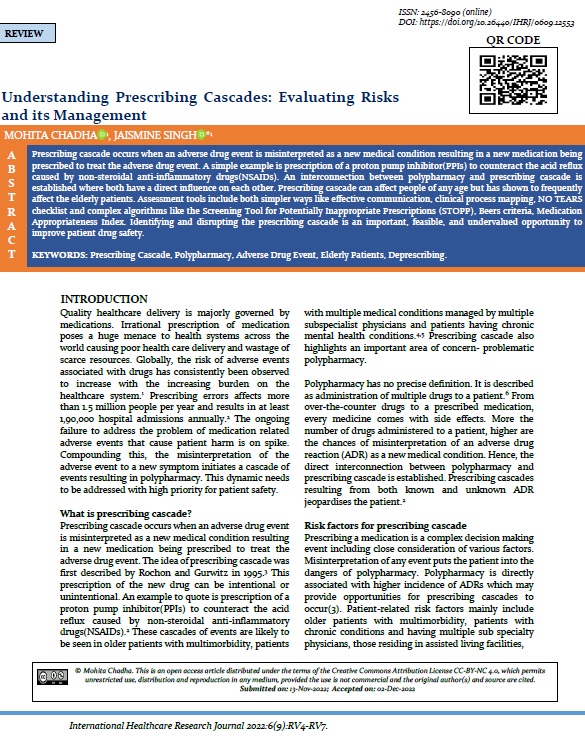Understanding Prescribing Cascades: Evaluating Risks and its Management
Abstract
Prescribing cascade occurs when an adverse drug event is misinterpreted as a new medical condition resulting in a new medication being prescribed to treat the adverse drug event. A simple example is prescription of a proton pump inhibitor(PPIs) to counteract the acid reflux caused by non-steroidal anti-inflammatory drugs(NSAIDs). An interconnection between polypharmacy and prescribing cascade is established where both have a direct influence on each other. Prescribing cascade can affect people of any age but has shown to frequently affect the elderly patients. Assessment tools include both simpler ways like effective communication, clinical process mapping, NO TEARS checklist and complex algorithms like the Screening Tool for Potentially Inappropriate Prescriptions (STOPP), Beers criteria, Medication Appropriateness Index. Identifying and disrupting the prescribing cascade is an important, feasible, and undervalued opportunity to improve patient drug safety.
Downloads
References
Ofori-Asenso R, Agyeman A. Irrational use of medicines—a summary of key concepts. Pharmacy. 2016;4(4):35.
Kalisch LM, Caughey GE, Roughead EE, Gilbert AL. The prescribing Cascade. Australian Prescriber. 2011;34(6):162–6.
Trenaman SC, Bowles SK, Kirkland S, Andrew MK. An examination of three prescribing cascades in a cohort of older adults with dementia. BMC geriatrics. 2021;21(1):1-1.
Doherty A, Moriarty F, Boland F, et al. Prescribing cascades in community-dwelling adults: protocol for a systematic review. HRB Open Research. 2021;4:72.
Halli-Tierney A, Scarbrough C, Carroll DG. Polypharmacy: evaluating risks and deprescribing. American family physician. 2019;100(1):32-8.
Guillot J, Maumus-Robert S, Bezin J. Polypharmacy: A general review of definitions, descriptions and determinants. Therapies. 2020;75(5):407-416.
Rochon PA, Petrovic M, Cherubini A, Onder G, O'Mahony D, Sternberg SA, et al. Polypharmacy, inappropriate prescribing, and deprescribing in older people: Through a sex and gender lens. The Lancet Healthy Longevity. 2021;2(5):e290-300.
Rochon PA, Schmader KE. Drug prescribing for older adults. Toronto: UpToDate. 2019.
Sternberg SA, Guy-Alfandary S, Rochon PA. Prescribing cascades in older adults. Canadian Medical Association Journal. 2021;193(6).
Schoen C, Osborn R, Huynh PT, Doty M, Davis K, Zapert K, et al. Primary care and health system performance: Adults' experiences in five countries. Health Affairs. 2004;23(Suppl1).
Rochon PA, Gurwitz JH. Optimising drug treatment for elderly people: The prescribing cascade. BMJ. 1997;315(7115):1096–9.
Tsiropoulos I, Andersen M, Hallas J. Adverse events with use of antiepileptic drugs: A prescription and event symmetry analysis. Pharmacoepidemiology and Drug Safety. 2009;18(6):483–91.
Vegter S, de Jong-van den Berg LT. Misdiagnosis and mistreatment of a common side-effect - angiotensin-converting enzyme inhibitor-induced cough. British Journal of Clinical Pharmacology. 2010;69(2):200–3.
Piggott KL, Mehta N, Wong CL, Rochon PA. Using a clinical process map to identify prescribing cascades in your patient. BMJ. 2020;:m261.
Pollock M, Bazaldua OV, Dobbie AE. Appropriate prescribing of medications: an eight-step approach. Am Fam Physician. 2007;75(2):231-6.

Copyright (c) 2022 Mohita Chadha et al.

This work is licensed under a Creative Commons Attribution-NonCommercial 4.0 International License.


